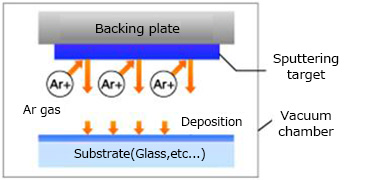1.Sorting of film deposition method
【Characteristics of sputtering】
- Deposition on large size of substrate is possible
- Strong adhesive deposition on substrate is possible
- Deposition on substrate material having high melting point is possible
- Homogeneous distribution of film deposition is possible
- Precision film quality and thickness control are possible
2.What is sputtering?
 After introducing an inert gas (mainly argon) in a vacuum chamber, by applying high voltage direct current or high voltage alternating current between a substrate and sputtering targets, gas such as argon is transformed as argon plasma.
After introducing an inert gas (mainly argon) in a vacuum chamber, by applying high voltage direct current or high voltage alternating current between a substrate and sputtering targets, gas such as argon is transformed as argon plasma.
The ions generated by this process are accelerated by an electric field and hit the target. Elements in the target fly out through this process and deposit on the surface of the substrate on the opposite side. Utilizing this principle, it is possible to form a film with a thickness in the order of nano to micron on the substrate surface.
3.Characteristics of thin film sputtering
As the cathode drop in sputtering plasma is very large such as around 400V, sputtering atom released by a target usually have large energy equivalent to about 10eV (much larger energy compared with the energy about 0.2eV of the atom released by the vapor deposition method). Because this high energy atom deposits on a substrate and becomes the thin film, the film of dense and more adhesive with a substrate can be formed.
Film deposition speed of the sputtering method was improved drastically by the establishment of the magnetron sputtering technology and, manufacturing productivity was enhanced remarkably by the development of large-scale in-line type coater. From such a background, state-of-the-art technology of the sputtering is expected to be applied in various newly developing needs in future.